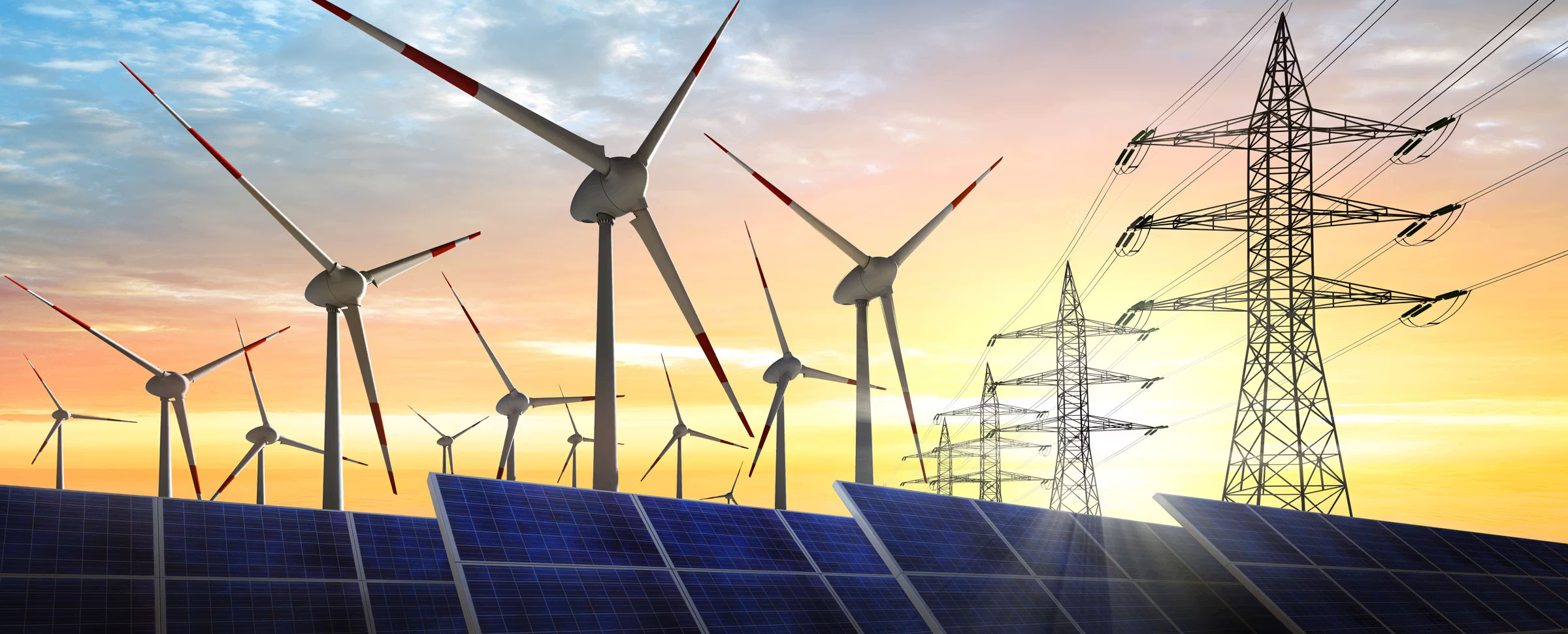
Renewable energy is on everyone’s mind — but how will the desire to convert to 100% renewable energy be accomplished? Clean energy efforts by states and the federal government are gaining momentum. Some states are enacting laws to decarbonize all sectors of the economy — and the Biden administration is signaling intentions to form public-private partnerships to address climate change. The electric utility industry and clean energy providers are positioned to be a part of this and experience major growth in sales.
Energy transmission lines that reach across much, but not all of the country, hold many challenges for the future. The transmission network of the high voltage, long distance power lines that carry electricity from power facilities and into communities today is a patchwork system, lacking centralized organization or long term planning. Understanding that the US cannot achieve 100% clean energy with the current methods to distribute resources, new approaches must prevail. The transport of renewable electric energy across state lines is critical, and a major hurdle to clear before reaching a future without fossil fuels.
How will the transmission lines get built to move this energy from geographically isolated places to urban and rural areas throughout the country? The US has massive renewable energy potential in many states — but that energy currently cannot be distributed across the country because the transmission infrastructure is not in place. In this issue of Everything Under Control we will provide a brief overview of the challenges that must be addressed — and the new technologies that are on the horizon to help resolve these issues.
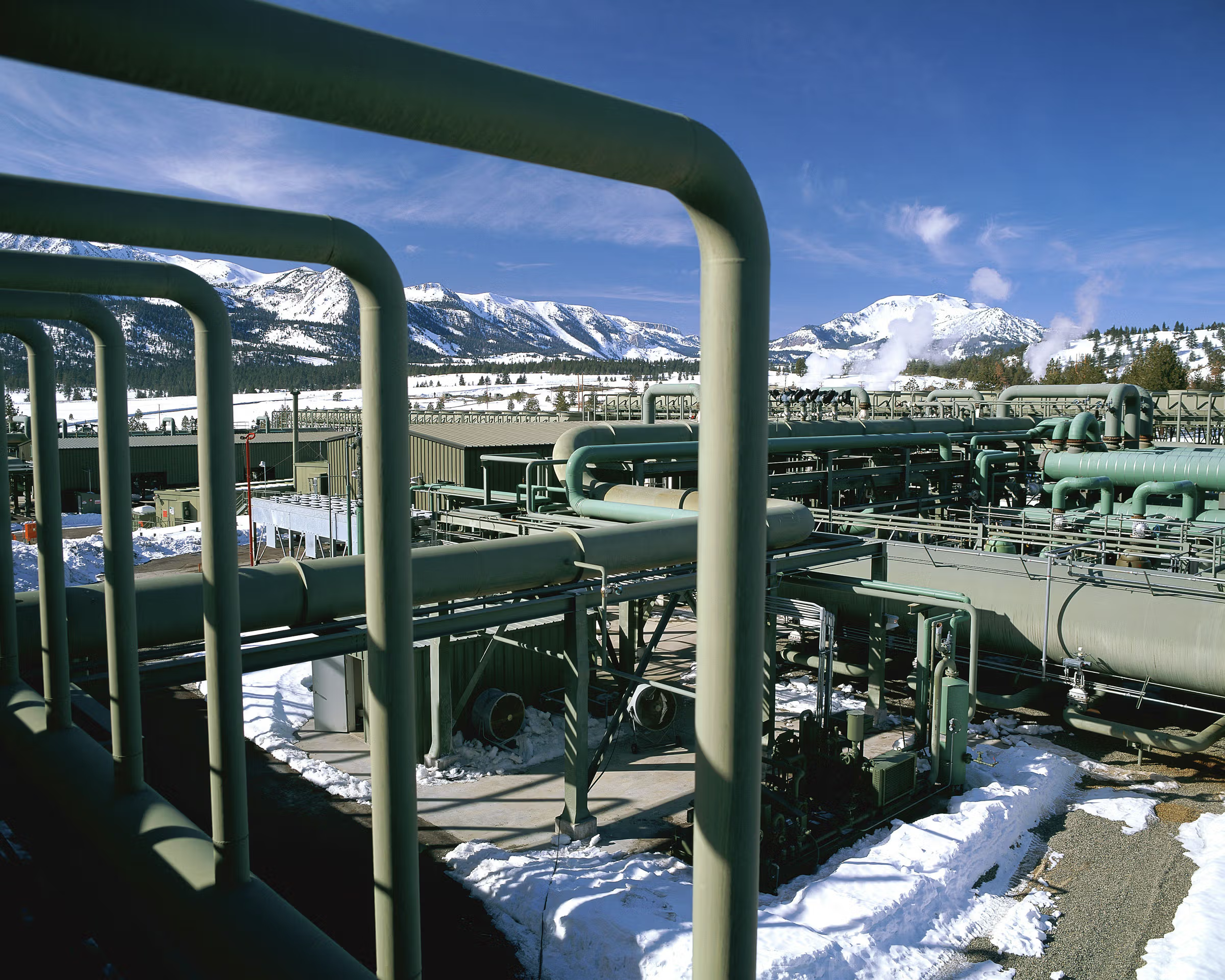
Renewable energy
Renewable energy is usable energy that is collected from renewable resources — which include sources like sunlight, wind, rain, rivers, tides, ocean waves and geothermal heat. Sources like these, that nature continuously replaces on a human timescale, have made renewable energy feasible.
These types of energy sources stand in contrast to fossil fuels, which are being used far more quickly than they can be renewed or replenished. In addition, as is the case with fossil fuels, using renewable energy results in no net addition of carbon dioxide to the atmosphere (carbon-neutral).
Alternative vs. renewable energy
Do not confuse the terms ‘renewable energy’ and ‘alternative energy.’ Alternative energy refers to an energy source that is an alternative to using coal, natural gas or petroleum — in other words, an alternative to fossil fuels. While ‘alternative’ means ‘instead of,’ ‘renewable’ means it does not deplete and can be relied upon indefinitely.
Renewable energy resources
- Geothermal energy is a form of renewable energy created by powering electrical generators with the heat of the earth. Geothermal power plants use heat from deep inside the earth to generate steam to make electricity. The heat is collected by a series of wells drilled one or two miles deep into the earth to pump steam or hot water from the naturally occurring subterranean hot water reservoirs to the surface.
Geothermal power plants are located in areas that have hot springs, geysers or volcanic activity, because these are places where the earth is particularly hot just below the surface. Geothermal heat pumps, which tap into heat closer to the earth’s surface, are used to heat water or provide heat for buildings of all types.
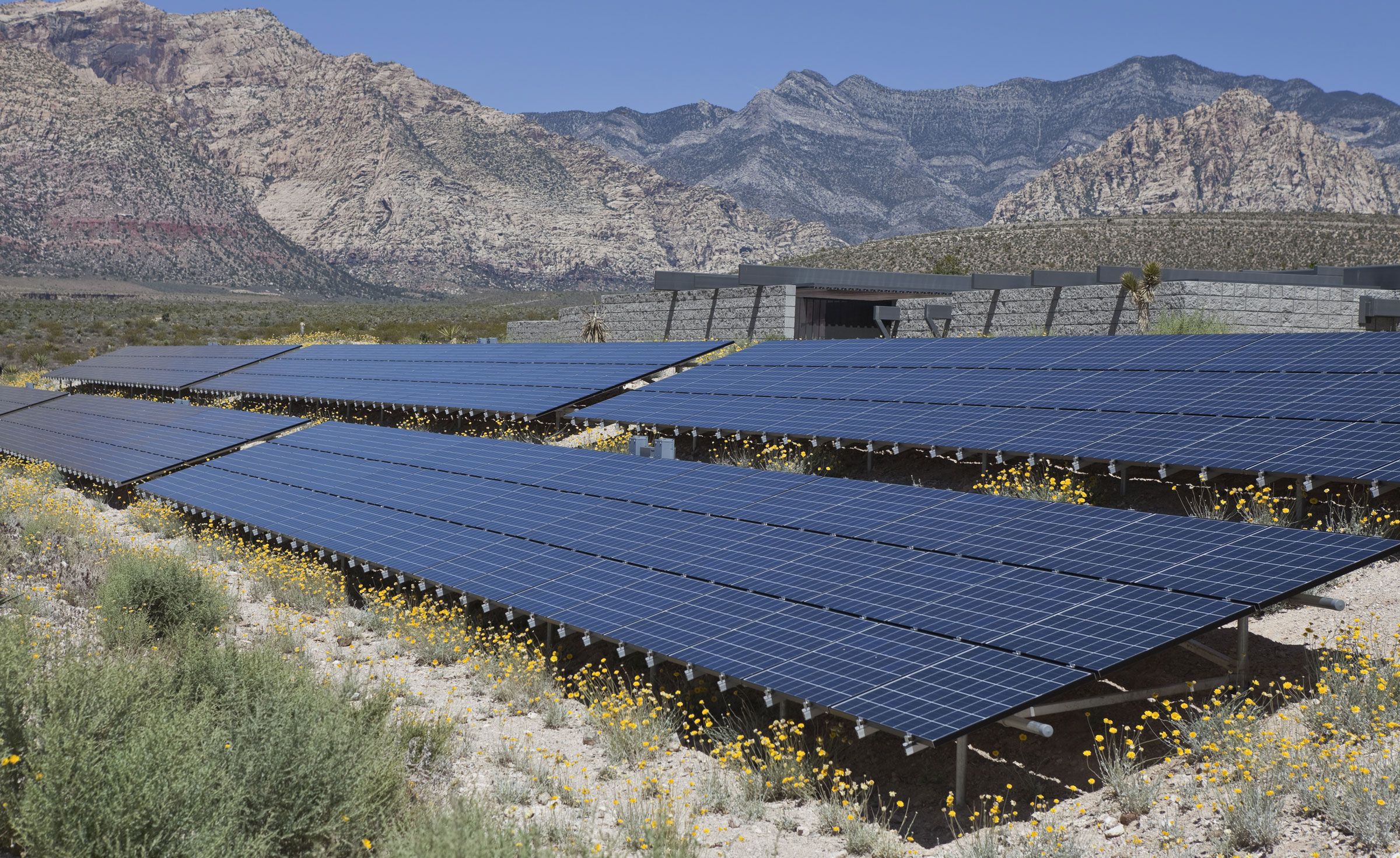
- Sunlight or solar energy is energy that transforms in ways that can be seen and felt. We see and feel evidence of the transfer of energy from the sun to earth when the sunlight warms the ground, bodies of water, and our skin.
Solar power is the conversion of that energy into electricity — either directly using photovoltaics (PV), indirectly using concentrated solar power or a combination. Concentrated solar power systems use lenses or mirrors and tracking systems to focus a large area of sunlight into a small beam. Photovoltaic cells convert light into an electric current using the photovoltaic effect.
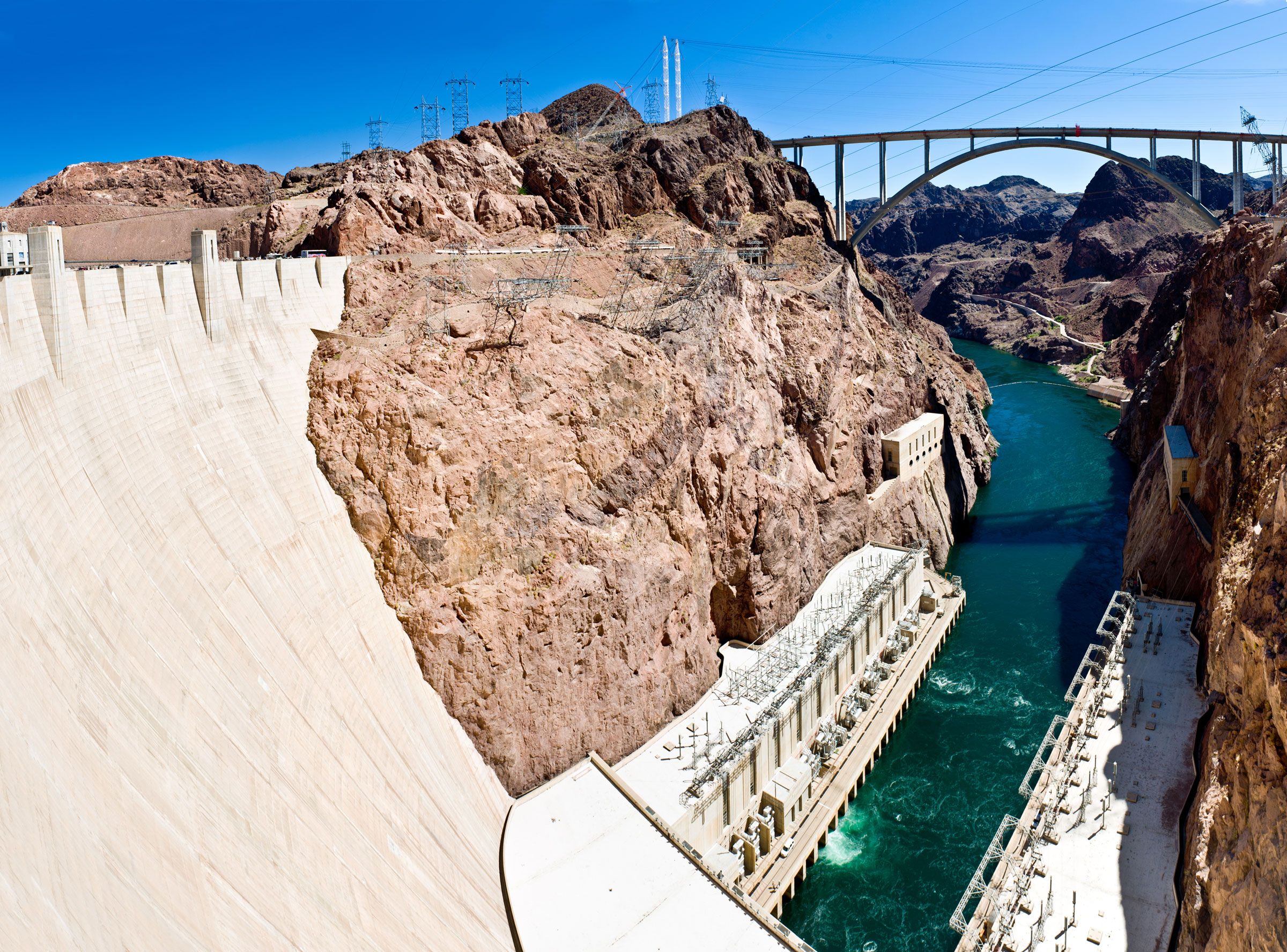
- Hydropower energy, hydro energy or water energy refers to capturing the energy in flowing or falling water and converting it into electricity. When this energy is converted into electricity, it is referred to as hydroelectricity. Since water is about 784 times denser than air, even a slow flowing stream of water can yield considerable amounts of energy.
Hydropower energy makes up a large portion of the renewable energy used today. In recent years, over 16% of the world’s total electricity came from hydropower and hydropower represented as much as 70% of all renewable energy that was converted into electricity.
Even though its share has declined due to the onslaught of advanced technologies in renewable energy, it will remain a major contributor to the renewable energy infrastructure in the future. In the overall scheme to harness renewable energy there are also developing technologies for generating electrical power from rainfall, high and low tide ranges, and ocean wave movement. With new technology advancing every day, the commercial use of these energy sources doesn’t seem too far off.
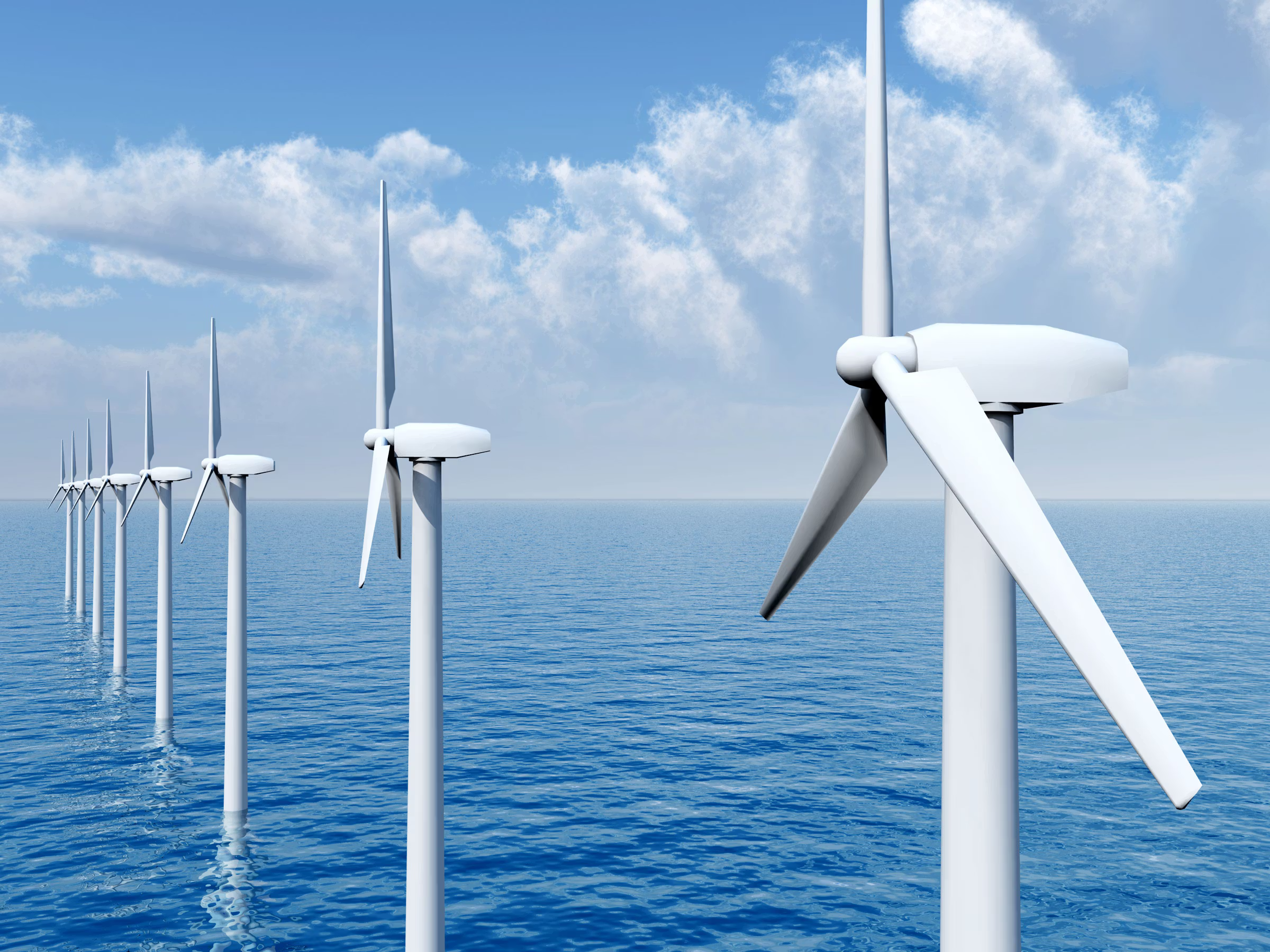
- Wind power or wind energy describes the process by which we use wind to generate electricity or mechanical power. Wind energy refers to capturing the energy from moving air and converting it into electricity. Wind energy is produced with tall, tubular towers with blades rotating at the top called wind turbines that turn a generator and create electricity.
Wind turbines convert the wind’s kinetic energy into mechanical power — and can provide energy that can be used onsite or sold commercially. Specific energy needs would determine the size of the turbine and how many may be needed.
The best place for a wind farm is obviously in a flat open area or offshore location. The wind must blow at an average of 14 miles per hour (22.5 km/h) or more to activate the turbine. The rapid evolution of wind technology over the past several years has led to an increase in the durability of wind turbines, offering an average operational lifespan of 20 to 25 years. - Biomass power or biomass energy is a carbon-neutral electricity generated from renewable organic waste that would otherwise be dumped in landfills. Renewable organic matter can include biological material derived from living or recently living organisms, such as wood, forest debris, manure waste, municipal waste, manufacturing waste and landfill gas.
Why is transmission important to the energy system?
The infrastructure for the transmission of electricity is the heart of the nation’s energy grid and will continue to play a key role in facilitating the ongoing transition to 100% clean energy.
In the past the US transmission grid has delivered power so reliably that widespread blackouts like the Northeast blackouts of 1965 and 2003 have been rare. Today with the increasing need to deliver more electricity, and with that electricity coming from many different sources, the infrastructure will need to be expanded and strengthened.
When electricity is generated, it must be transmitted from the power plant to local distribution grids on high-voltage power lines before it can be distributed to homes and businesses. With the demand for more electricity increasing and the introduction of new laws and regulations, the power grid needs massive updating.
How electricity transmission works
The characteristic feature of modern electricity transmission is the high-voltage power lines that stretch across much of the country. In the US, there are nearly 200,000 miles of high-voltage transmission lines that transmit up to 345,000 volts over long distances. Because about 6 percent of the power generated is lost in transit due to the heat created by resistance from the wires, high voltage is critical to accomplish efficient transmission.
Even materials that are excellent conductors of electricity, such as copper and aluminum, provide some resistance to the flow of electrons — and the accompanying power loss can be substantial over long distances. All high-voltage transmission lines are networked together to create a pathway to move electricity from the power plants where it is generated to local distribution systems.
These local distribution systems, or substations, ultimately deliver it to homes and businesses. These substations distribute electricity to customers over a transmission system referred to as the power grid. Initially, electricity flows through the grid at very high voltage. Voltage is increased or decreased to make transmissions more efficient over long distances. The voltage can then be lowered or raised, depending on the type of customers receiving the electricity. For instance, the common user voltage for the US will be 120 V and 240 V — while in some cases, a large industrial user may receive higher voltage depending on the energy requirements.
US independent grids
There are three large, independent AC grids across the country — Eastern Interconnection that covers the eastern two-thirds of the US, the Western Interconnection that covers the western third, and the Texas Interconnection that covers 85 percent of the state of Texas. Each has multiple utilities and independent power producers supplying electricity to the grid — and different pieces of the grid are owned by a number of independent transmission companies, utilities, municipalities and federal power marketers.
Monitoring the grid
Each grid is actively monitored 24 hours a day by various grid operators, also called balancing authorities. These balancing authorities work to keep the electric grid in balance at all times by making sure that the supply of electricity meets the demand in real time. Currently, no technology exists that can store electricity cost-effectively on a large scale. For that reason, balancing authorities rely on generators to respond to changes in usage on demand.
Transmission lines
Transmission lines are sets of wires called conductors, which carry electric power from generating plants to the substations that deliver power to customers. At a generating plant, electric power is “stepped up” to several thousand volts by a transformer and delivered back to the transmission line. In addition, numerous substations on the transmission system use transformers to “step down” the power to a lower voltage and deliver it back to distribution lines.
Overhead transmission lines are cables installed above the ground used for electric power transportation from one location to another. The cables are installed across the many towers placed from one destination to another. Overhead distribution lines in residential, city and rural areas carry power to homes, offices, businesses and farming communities. The type of transmission structures used for any project is determined by the characteristics of the transmission line’s route, including terrain and other existing infrastructure.
Underground transmission lines are cables that must be installed three to five feet below the ground. This is a more expensive way to build power lines, but it has many advantages that overhead lines cannot offer. The “undergrounding,” as it is called, is a method of electric distribution that will help to beautify scenic highways, major roadways and thoroughfares, as well as civic, commercial and residential areas, by minimizing the disruption of the landscape. Undergrounding elevates property value in communities, reduces urban and industrial blight, enhances electric reliability, and makes wildfire prone areas safer.

Economics of electricity transmission
Transmission makes up nearly eleven percent of the total cost of electricity. Although transmission represents a small portion of the overall cost of electricity, building and expanding the electricity transmission infrastructure is very expensive. The size and complexity of the transmission system are significant barriers to entry for new companies because of the massive initial capital investment needed to transmit power. Transmission projects cost hundreds of millions of dollars and require long lead times and many right-of-way easements.
Because of these high capital and administrative costs, the transmission system exhibits what is called “economies of scale.” This means, as the system gets larger, the cost per unit of electricity goes down and it becomes increasingly difficult to build a competing system that is economical. As a result, only one utility will supply a given area with just one grid — creating a “natural monopoly.” The unique economic structure of electricity transmission is one of the main justifications for government regulation in this industry.
Wholesale electricity markets
Organized wholesale markets, often referred to as Regional Transmission Organizations (RTOs), now deliver power to about two-thirds of the country. With real-time or spot markets, as well as day-ahead markets for electricity, prices within RTOs reflect electricity supply and demand conditions — as well as transmission congestion, or bottlenecks, and associated additional costs.
100 percent renewable energy goals
Hawaii became the first state in the country to pass a 100 percent renewable energy target. In 2015, Governor David Ige signed into law four energy bills, including a Renewable Portfolio Standards (RPS) that strengthens Hawaii’s commitment to clean energy. This law directs the state’s utilities to generate 100 percent of their electricity sales from renewable energy resources by 2045.
Over the last few years, a number of other US states and territories have followed suit. More than a dozen have now established targets to procure all of their electricity from either renewable or non-carbon-emitting resources by a specific published date.
As individual states consider or pass legislation, the policies and structures being written and implemented will be different in a number of ways. Each state will decide what their best path to reaching 100% renewable energy is — and states can also define what technologies are eligible to count towards the RPS requirements.

100 percent renewable energy vs. 100 percent clean energy
There are two primary types of targets that states are setting — 100 percent renewable energy and 100 percent clean energy. Although the two types of targets sound like the same thing, there is a major difference. Renewable energy targets explicitly require that electricity is generated from renewable resources like solar, wind, hydropower and geothermal. Clean energy targets allow for compliance from any non-carbon-emitting resources, such as nuclear generators.
Both types of targets result in a 100 percent reduction of carbon emissions from electricity production, however the methods used to reach those targets are quite different. The ongoing debate over the role of nuclear energy in a clean energy transition continues to be a divisive exchange. The specific wording of state targets will describe in detail the method each state or territory plans to incorporate.
States with 100 percent renewable and clean energy targets
Below is a list of US states and territories, as well as the District of Columbia with either 100 percent renewable energy or 100 percent clean energy targets that have been passed into law or signed as an explicit goal through executive orders.
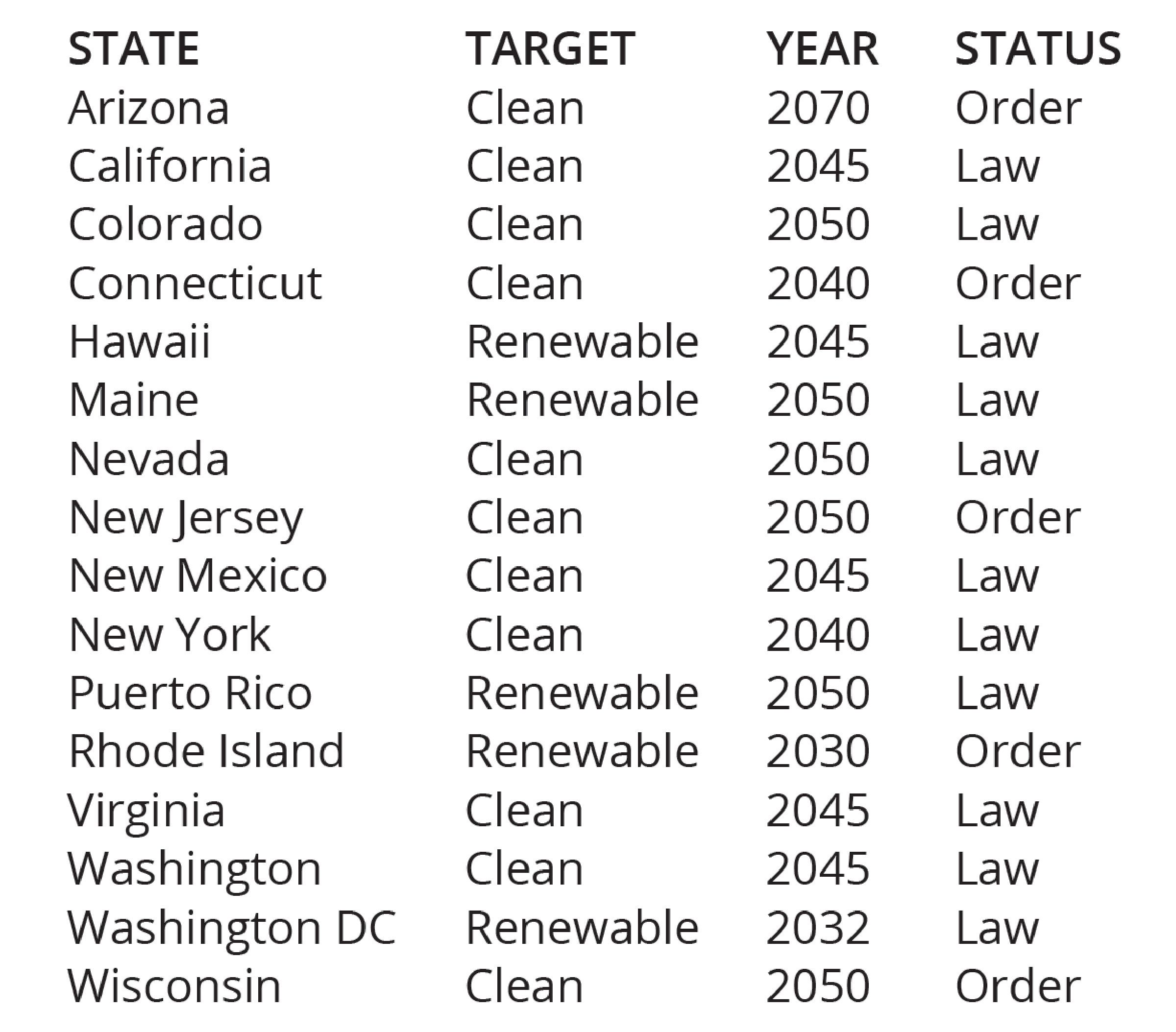
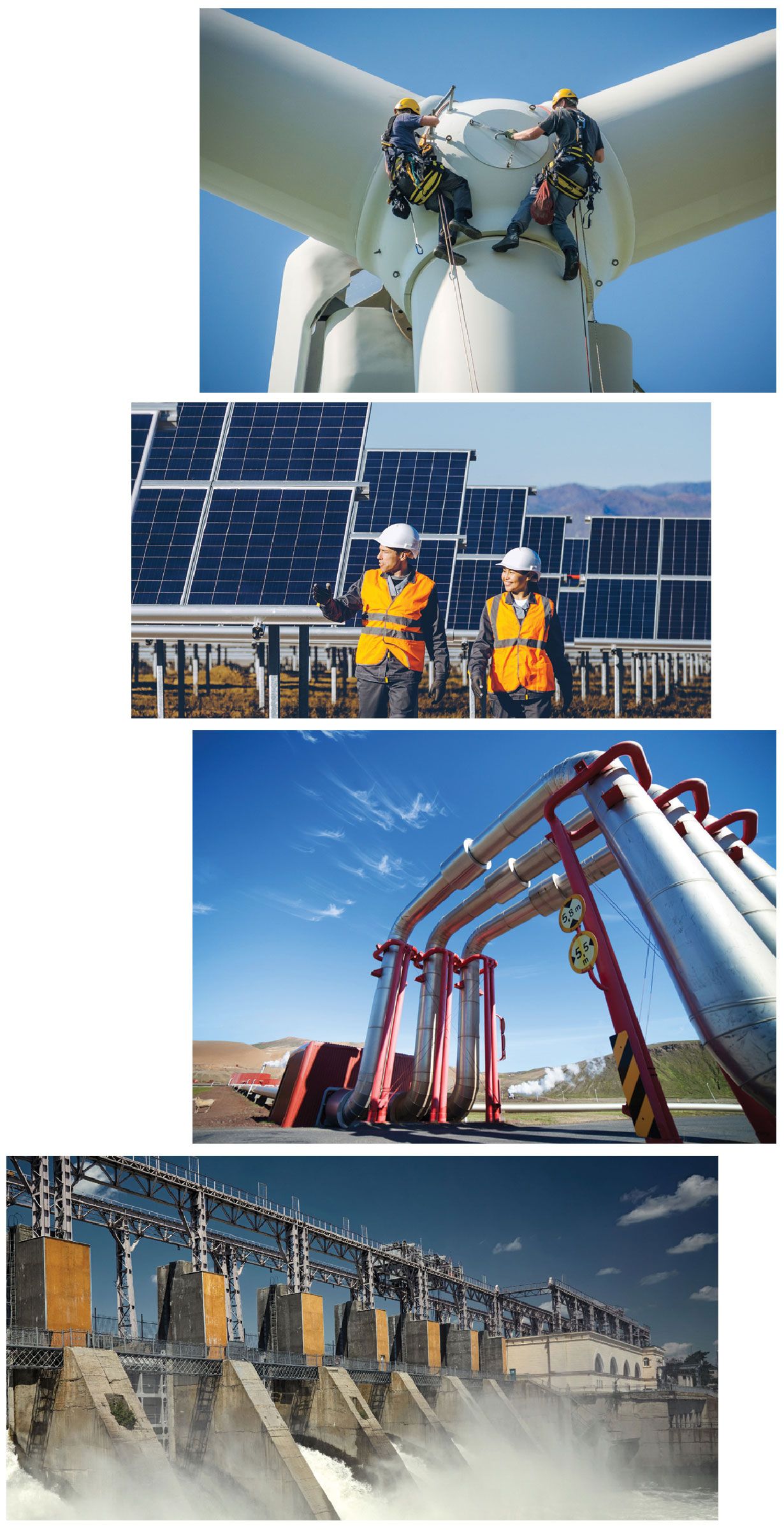
What are renewable portfolio standards?
Renewable portfolio standards (RPS), which is also referred to as renewable electricity standards (RES), are policies designed to increase the use of renewable energy sources for electricity generation. These policies require or encourage electricity suppliers to provide their customers with a stated minimum share of electricity from eligible renewable resources.
Today, a number of states and territories, as well as the District of Columbia, have enacted their own RPS programs. In addition, most states have voluntary goals or objectives for renewable energy generation within defined time frames. A National RPS or other clean energy policies have been proposed, but currently no federal RPS or similar policy is in place.
What does a renewable portfolio standard do?
A renewable portfolio standard (RPS) is a law that requires electric utilities in a state or territory to generate a specific percentage of electricity from renewable sources by a certain date. If a utility company fails to meet these goals, it can be subject to large fines.
An RPS is most successful in driving renewable energy projects when combined with the federal production tax credit. The renewable electricity production tax credit (PTC) is a per kilowatt-hour (kWh) federal tax credit included under Section 45 of the U.S. tax code for electricity generated by qualified renewable energy resources.
The PTC tax credit provides varied levels of corporate tax credits on electricity generated from landfill gas (LFG), open-loop biomass (animal waste and other organic materials), closed-loop biomass (organic material that is planted to be used to produce electricity), municipal solid waste resources, qualified hydroelectric, and marine and hydro-kinetic, wind and geothermal resources.
Different types of state RPS programs
States or territories will often design an RSP to drive particular technologies by providing specific provisions that mandate a certain percentage of electricity generated comes from a particular
technology (e.g., solar or biomass).
RPS programs vary widely in terms of program structure, mechanisms, enforcement, size and application. No two RPS programs will be exactly the same. Some states or territories may choose to apply the RPS requirements to all its utilities operating in the state, while others apply to only the investor-owned utilities.
RPS implementation hurdles
Maintaining sufficient transmission capacity for the generation of electricity from any renewable resource is extremely important and a prerequisite for the success of an RPS. States or territories with a successful RPS either have sufficient transmission currently or plans to build it. Those that do not have enough transmission capacity need to invest in new equipment and technology to be able to adapt to renewable energy and become part of a stronger more stable nationwide transmission of electricity.
Ratepayer impacts of an RPS can also stall its adoption politically. A counterbalance to the impacts on ratepayers is that RPS mandates usually drive local economic growth. Under a well-designed RPS, costs are shared fairly by all ratepayers. Another way to address ratepayer impacts is to include provisions in the RPS to prevent costs from excessive escalation.
Best practices for the design of an RPS
- RPS targets should be stable, ramp up steadily over time, and not be subject to sudden or uncertain shifts.
- An RPS program should be of sufficient duration to allow for long-term contracting and financing.
- An RPS program should apply to all load-serving entities — including investor-owned, municipal and electric cooperatives.
- The eligibility of specific renewable energy technologies and generators should be well defined.
- The use of tradable renewable energy credits for RPS compliance should be considered and adhered to with a robust tracking system.
- The cost of RPS compliance should be allocated fairly across all utility customers.
- RPS programs should be mandatory and impose noncompliance penalties on those entities that fail to meet requirements.
Renewable energy certificate (REC)
A renewable energy certificate (REC) is a market-based instrument that protects the property rights to the environmental, social and other non-power attributes of renewable electricity generation. RECs are issued when one megawatt-hour (MWh) of electricity is generated and delivered to the electricity grid from a renewable energy resource.
RECs provide vital information
The electricity we receive through the utility grid doesn’t provide its origin, how it was generated, or what renewable resource it was generated from. RECs play an important role in accounting, tracking and assigning ownership to renewable electricity generation and use. On a shared grid, whether from on-site or off-site resources, RECs are the instrument that electricity consumers must use to substantiate renewable electricity use claims.
RECs usual information
- Certificate Data
- Certificate type
- Tracking system ID
- Renewable energy type
- Renewable facility location
- Nameplate capacity of project
- Project name
- Project vintage (date built)
- Certificate (generation) vintage
- Certificate unique identification number
- Utility to which project is interconnected
- Eligibility for certification or RPS
- Emissions rate of the renewable resource
Note: Depending on the market in which the REC is generated, other attributes may be associated with the certificate.
Legal basis of RECs
RECs are the accepted legal instrument through which renewable energy generation and use claims are substantiated in the US renewable energy market. RECs are supported by US case law and numerous different levels of government, regional electricity transmission authorities, nongovernmental organizations (NGOs), and national trade associations.
REC arbitrage strategy
REC arbitrage is a procurement strategy used by electricity consumers to simultaneously meet two objectives. One objective is to decrease the cost of their renewable electricity use — and the second is to substantiate renewable electricity use and carbon footprint reduction claims. The strategy is used by consumers installing self-financed renewable electricity projects or consumers who purchase renewable electricity directly from a renewable electricity project, such as through a power purchase agreement (PPA).
Arbitrage is the nearly simultaneous buying and selling of commodities in different markets in order to take advantage of differing prices for the same or similar assets. REC arbitrage occurs when RECs from one renewable electricity project are sold and replaced by less expensive RECs from another renewable electricity project.
In the United States, RECs vary in price. While all RECs represent one megawatt-hour (MWh) of renewable electricity, each REC is made up of the specific characteristics as to where, when and what renewable resource produced that particular REC. The specific characteristics contained in each REC lead to uneven market supply and demand for differing RECs, which in turn results in differences in prices. If consumers prefer landfill gas RECs over wind RECs, the additional demand will lead to higher prices compared to wind RECs.
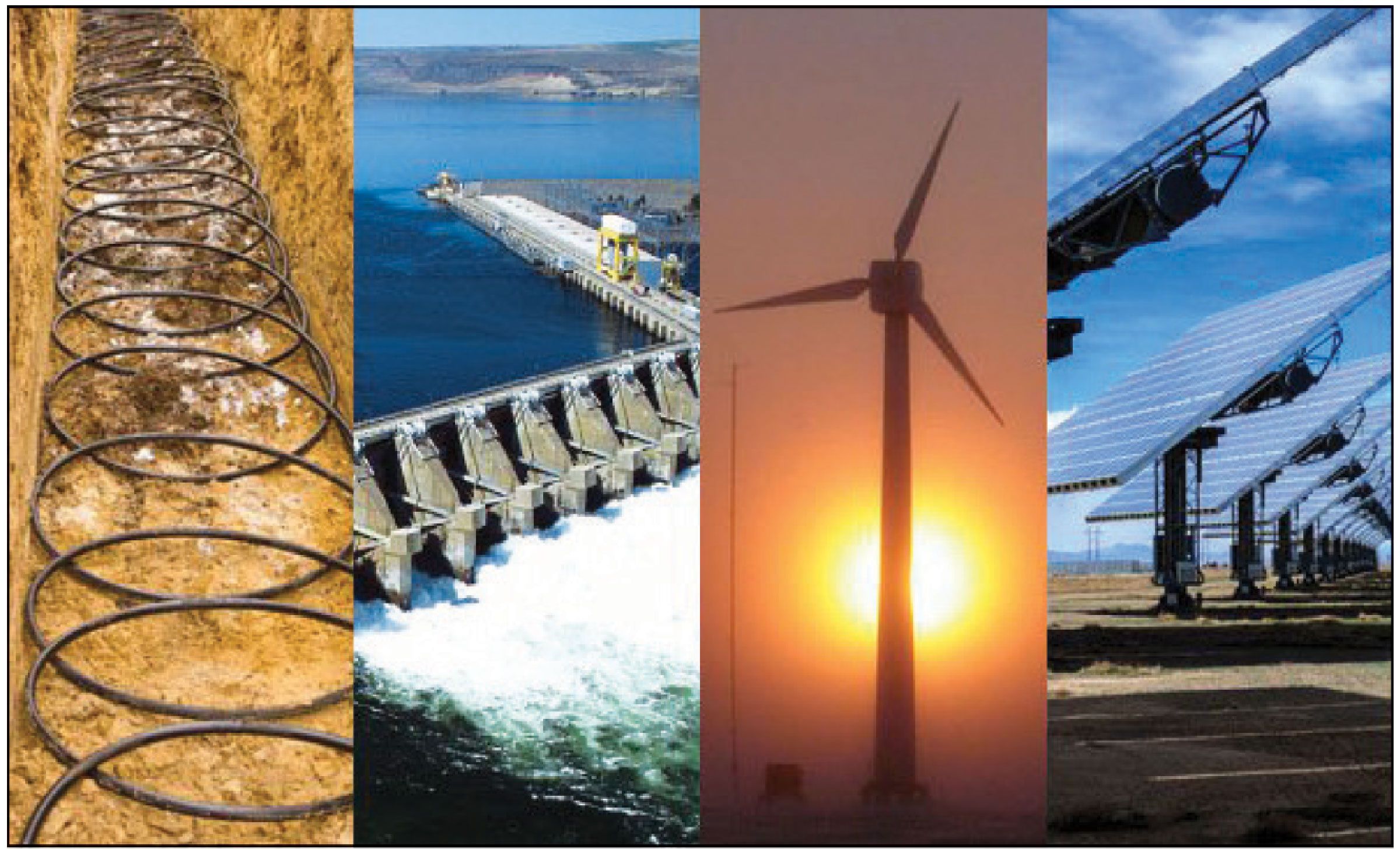
RPS increases electricity generation from eligible renewable resources
States with and without RPS policies are experiencing increases in the amount of electricity generated from renewable resources. A combination of federal incentives and market conditions, as well as state RPS policies and other programs, have driven increases in renewable electricity generation.
States have generally met their interim RPS targets in recent years, with only a few exceptions reflecting unique, state-specific policy designs. Nearly half of all growth in US renewable electricity generation and capacity since 2000 is associated with state RPS requirements.
Within regions in the United States, such as the Northeast and Mid-Atlantic, RPS policies continue to serve a central role in motivating growth in renewable electricity generation. Although some regions may produce excess RPS-qualifying generation, others may produce just enough to meet the requirement or may need to import electricity from nearby regions to meet state targets.
RPS programs and clean energy targets here to stay
A wide range of policies fall under the RPS programs. The RPS set a minimum requirement for the share of electricity supply that comes from designated renewable energy resources by a certain date or year. As standard, these resources include wind, solar, geothermal, biomass and some types of hydroelectricity, but they can also include other resources such as landfill gas, municipal solid waste and ocean energy. Some programs contain credits for various types of renewable space heating and water heating, fuel cells, energy efficiency measures, and advanced fossil-fueled technologies.
In addition to renewable energy standards, some states have set clean energy targets or goals. These states have defined terms such as carbonfree, carbon-neutral, or clean energy in different ways. For example, some states may allow technologies such as nuclear energy, or natural gas with carbon capture and storage, to count toward clean energy policy targets.
As a rule, RPS policies feature a renewable electricity credit (REC) trading system that reduces the cost to comply with the RPS. A utility that generates more renewable electricity than the RPS requirement may either trade or sell RECs to other electricity suppliers who may not have enough RPS-eligible electricity to meet their RPS requirements.
Some states reserve a certain number of credits available for sale. In general, the only entities that may take credit for the renewable attribute of generation from RPS-eligible sources are the original generator and the REC purchaser. In addition to the cost-control mechanism of an REC, many RPS programs have escape clauses if renewable generation exceeds a specified cost threshold.
Future of electricity transmission
The future of the electricity transmission grid is generally bright with investment now hitting its highest levels in decades. Renewables are playing a major role in transmission grid investment as the influx of renewable generation projects is driven largely by policies, such as the wind production tax credit and state-level renewable energy mandates.
Many calls for increased transmission investment come from renewables advocates and politicians pushing for increased adoption of wind and solar power. Other federal policies are also quietly driving transmission investment towards renewable projects like wind and solar facilities.
In July 2011, the Federal Energy Regulatory Commission (FERC) issued Order 1000. The stated purpose was to increase regional transmission development by eliminating long-standing monopolies and create competition and incentives for innovative, cost-effective projects. FERC stated: “Order 1000 will remove barriers to the development of transmission, promoting cost-effective planning and the fair allocation of costs for new transmission facilities. This enhanced transmission planning will provide a strong foundation for updating the grid to provide reliable transmission service as well as an opportunity to achieve goals that states, and local authorities have set for lower emissions, demand-side resources and renewable energy.” Order 1000, along with other policy changes stemming from the Energy Policy Act of 2005, are certainly increasing the level of investment in the transmission grid.
In contrast, market-driven investments in transmission lines strive to increase grid reliability and reduce transmission congestion by focusing on the highest-valued grid improvements. These investments may allow existing low-cost power to reach the areas where it is needed most.
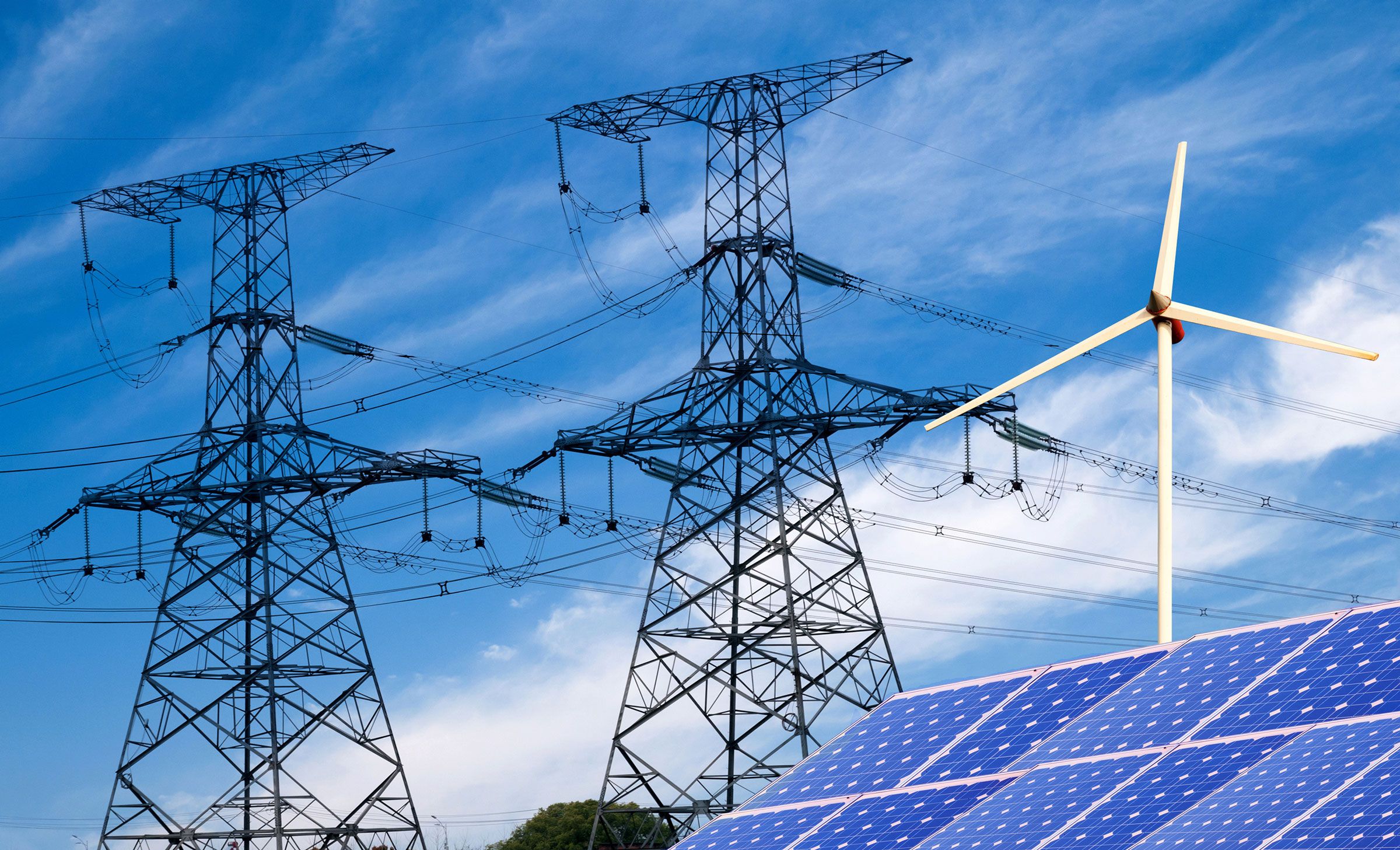
Existing on just renewable energy
Is it possible for a country to exist purely on renewable energy? A few years ago, some people said it was not and that it would never happen. However, many countries have already adopted plans that are taking them in that direction.
Iceland, as an example, already gets 85% of its electricity from the earth’s heat. Its electricity depends 100% on geothermal and hydropower. Norway gets approximately 98% of its electricity from renewable energy — and several more countries are adopting ambitious plans to obtain their power from renewable energy.
To say that renewable energy is here to stay is an understatement. The US and the rest of the world are using fossil fuels far more quickly than they can be renewed or replenished. Renewable energy comes from natural resources that, when managed correctly, can last forever and has the additional advantage of resulting in no net addition of carbon dioxide to the atmosphere.
Electrical machine controls for over four decades
We hope you have benefited from this issue of EVERYTHING UNDER CONTROL and that this information helps you to understand what the future will bring to renewable energy infrastructure and what resources and technologies play a major role in achieving the ultimate goal of 100% clean energy for our country.
In future issues, we will present information on the latest trends and advancements for a wide variety of industries that depend on c3controls products as an integral part of their machine controls.
ISO 9001:2015
Certified
17+ Million Product
Configurations
Lifetime
Warranty
Guaranteed
Same-Day Shipping
Advantage Pricing
Save Up To 40%
c3controls Headquarters, USA
664 State Avenue
Beaver, PA 15009
